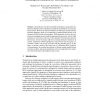534 search results - page 29 / 107 » Agent-environment interaction in a multi-agent system: a for... |
122
click to vote
BMCBI
2010
14 years 11 months ago
2010
Background: Several diseases, many of which nowadays pandemic, consist of multifactorial pathologies. Paradigmatic examples come from the immune response to pathogens, in which ca...
ATAL
2004
Springer
15 years 4 months ago
2004
Springer
Abstract. Positioned at the confluence between human/machine and hardware/software integration and backed by a solid proof of concept realized through several scenarios encompassin...
CIBB
2009
15 years 4 days ago
2009
Modelling activities in molecular biology face the difficulty of prediction to link molecular knowledge with cell phenotypes. Even when the interaction graph between molecules is k...
84
Voted
E4MAS
2004
Springer
15 years 2 months ago
2004
Springer
Abstract. Decentralised, event-driven distributed simulation is particularly suitable for modelling systems with inherent asynchronous parallelism, such as agentbased systems. Howe...
ENTCS
2007
14 years 11 months ago
2007
Formal sequentialization is introduced as a rewriting process for the reduction of parallelism and internal communication statements of distributed imperative programs. It constru...


